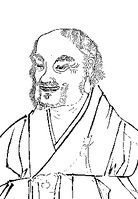Jingxi Zhanran
| English Phonetics | Jingxi Zhanran |
|---|---|
| Chinese Script | 荊溪湛然 |
| Japanese Transliteration | Keikei Tannen |
| Korean Transliteration | Hyŏnggye Tamyŏn |
- Qi (戚)
- Jingqi 荊溪
- Great Master Miaole (Sublime Bliss)
- Dharma Master Jizhu (Lord of Exegesis)
| Birth: | 711 |
|---|---|
| Death: | 782 |
| Place of birth: | Jingqi, (present-day Jiangsu province) |
Tibetan calendar dates
- Religious Affiliation
- Tiantai
- Teachers
- Xuanlang (673–754)
Other Biographical info:
- Wiki Pages
- Person description or short bio
- Jingxi Zhanran. (J. Keikei Tannen; K. Hyŏnggye Tamyŏn (711–782). Chinese monk who is the putative ninth patriarch of the T ia n t a i z o n g ; also known as Great
Master Miaole (Sublime Bliss) and Dharma Master Jizhu (Lord of Exegesis). Zhanran was a native of Jingqi in present-day Jiangsu province. At age nineteen, Zhanran became a Student of the monk Xuanlang (673-754), who had revitalized the community on Mt. Tiantai. After Xuanlang’s death, Zhanran continued his efforts to unify the disparate regional centers of Tiantai learning under the school’s banner; for his efforts, Zhanran is remembered as one of the great revitalizers of the Tiantai tradition. A gifted exegete who composed numerous commentaries on the treatises of T ia n t a i Z h iy i, Zhanran established Zhiyi’s M o h e z h i g u a n , F a h u a x u a n y i, and F a h u a w e n ju as the three central texts of the Tiantai exegetical
tradition. His commentary on the Mohe zhiguan, the M ü h e z h ig u a n FUXING ZHUANHONG j u f , is the first work to correlate z h ig u a n (calmness and insight) practice as outlined by Zhiyi with the teachings of the S a d d f ia r m a p u n d a r Ik a s ü t r a (“Lotus Sütra”), the central scripture of the Tiantai tradition. In his J in g a n g Pi (“Adamantine Scalpel”), Zhanran argued in favor of the controversial proposition that insentient beings also possess the buddha-nature (f o x in g ). Zhanran’s interpretation of Tiantai doctrine and the distinction he drew between his own tradition and the rival schools of the H u a y a n z o n g and C h a n z o n g set the stage for the internal Tiantai debates during the Song dynasty between its on-mountain (shanjia) and off-mountain (shanwai) branches (see S h a n jia S h a n w a i). Zhanran lectured at various monasteries throughout the country and was later invited by emperors Xuanzong (r. 712-756), Suzong (r. 756-762), and Daizong (r. 762-779) to lecture at court, before retiring to the monastery Guoqingsi on Mt. Tiantai.
Expand to see this person's philosophical positions on Buddha-nature.
| Is Buddha-nature considered definitive or provisional? | |
|---|---|
| Position: | |
| Notes: | |
| All beings have Buddha-nature | |
| Position: | |
| If "Qualified", explain: | |
| Notes: | |
| Which Wheel Turning | |
| Position: | |
| Notes: | |
| Yogācāra vs Madhyamaka | |
| Position: | |
| Notes: | |
| Zhentong vs Rangtong | |
| Position: | |
| Notes: | |
| Promotes how many vehicles? | |
| Position: | |
| Notes: | |
| Analytic vs Meditative Tradition | |
| Position: | |
| Notes: | |
| What is Buddha-nature? | |
| Position: | |
| Notes: | |
| Svātantrika (རང་རྒྱུད་) vs Prāsaṅgika (ཐལ་འགྱུར་པ་) | |
| Position: | |
| Notes: | |
| Causal nature of the vajrapāda | |
| Position: | |
